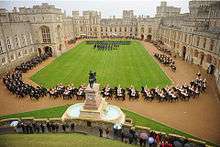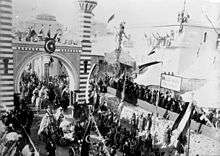State visit

A state visit is a formal visit by a head of state to a foreign country, at the invitation of that country's head of state, with the latter also acting as the official host for the duration of the state visit. Speaking for the host, it is generally called a state reception. State visits are considered to be the highest expression of friendly bilateral relations between two sovereign states, and are in general characterised by an emphasis on official public ceremonies.
Less formal visits than a state visit to another country with a lesser emphasis on ceremonial events, by either a head of state or a head of government, can be classified (in descending order of magnitude) as either an official visit, a working visit, or a private visit.
In parliamentary democracies, while heads of state in such systems of government may formally issue and accept invitations, they do so on the advice of their heads of government, who usually decides on when the invitation is to be issued or accepted in advance.
Queen Elizabeth II is "the most travelled head of state in the world," having made 261 official overseas visits and 96 state visits to 116 countries by the time of her Diamond Jubilee in 2012.[1] Although she is sovereign of each of the Commonwealth realms, in practice, she usually performs full state visits as Queen of the United Kingdom, while the relevant governor-general undertakes state visits for his or her respective country on the sovereign's behalf. However, the Queen has occasionally made some state and official visits representing one of her other Commonwealth realms.
Components of a state visit

State visits typically involve some or all the following components (each host country has its own traditions):
- The visiting head of state is immediately greeted upon arrival by the host (or by a lesser official representative, if the two heads of state are to meet later at another location) and by his or her ambassador (or other head of mission) accredited to the host country.
- A 21-gun salute is fired in honor of the visiting head of state.
- The playing of the two national anthems by a military band. The guest country's anthem is usually played first.
- A review of a military honor guard or guard of honour.
- The visiting head of state is formally introduced to senior officials/representatives of the host country and the hosting head of state is introduced to the delegation accompanying the visiting head of state.
- An exchange of gifts between the two heads of state.
- A state dinner, either white tie or black tie, is mounted by the hosting head of state, with the visiting head of state being the guest of honor.
- A visit to the legislature of the host country, often with the visiting head of state being invited to deliver a formal address to the assembled members of the legislature.
- High-profile visits by the visiting heads of state to host country landmarks such as laying a wreath at a military shrine or cemetery.
- The staging of cultural events celebrating links between the two nations.
The visiting head of state is usually accompanied by a senior government minister, usually by a foreign minister. Behind the diplomatic protocol, delegations made up from trade organizations also accompanies the visiting head of state, offered an opportunity to network and develop economic, cultural, and social links with industry leaders in the nation being visited. At the end of a state visit, the foreign head of state traditionally issues a formal invitation to the head of state of the nation being visited who at another time in the future, would pay a reciprocal state visit.
While the costs of a state visit are usually borne by state funds of the host country, most nations host fewer than ten state visits per year, with some as few as two. Most foreign heads of state will stay in the official residence of the head of state who is hosting the state visit, in a guest house reserved for foreign visitors, or in their own nation's embassy located in the foreign nation being visited.
State visits by well-known global leaders, such as Elizabeth II, the President of the United States or the Pope, often draw much publicity and large crowds. Occasionally, these include protesters.
See also
| Wikimedia Commons has media related to State visits. |
- List of state and official visits by Canada
- Air transports of heads of state and government
- Honors music
- Motorcade
- Order of precedence
- Reciprocity (international relations)
- State funeral
- State visits to the United States
- Summit (meeting)
- Very Important Person
References
- ↑ Campbell, Sophie (11 May 2012). "Queen's Diamond Jubilee: sixty years of royal tours". The Telegraph (Online edition). Retrieved 23 September 2016.